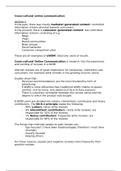Samenvatting
Summary of all lectures and papers discussed in Crosscultural Online Communication
This summary consists of all you need to know for the exam of the second year's subject of International Business Communication: CrossCultural Online Communication. It consists of the lecture notes and a summary of the following research papers: - Gudykunst & Ting-Toomey (1988): Verbal Communica...
[Meer zien]




